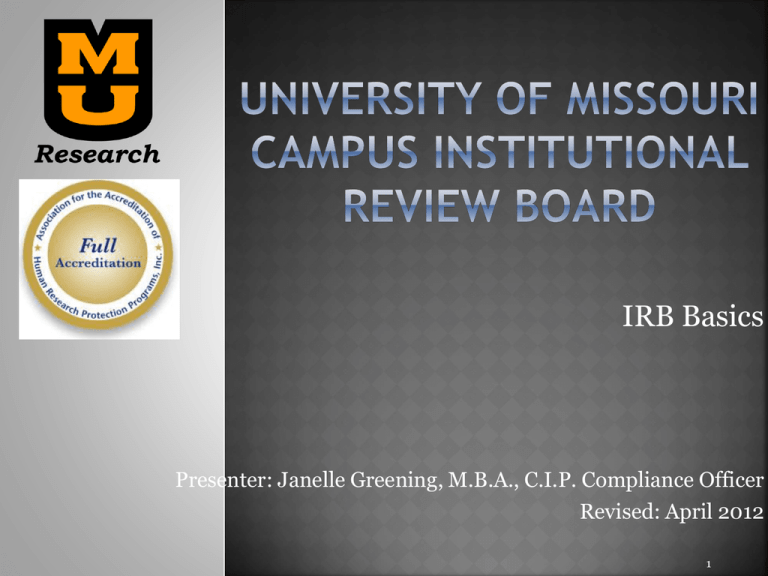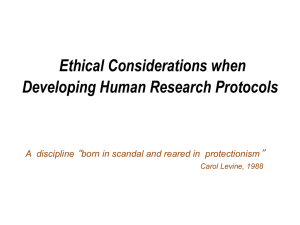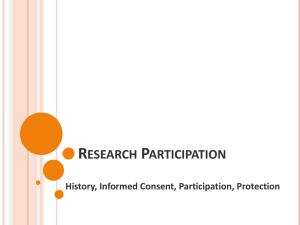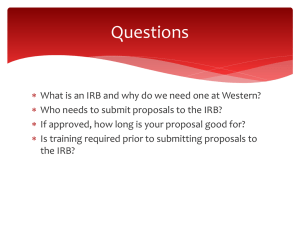Basic CIRB Training - Office of Research
advertisement

IRB Basics Presenter: Janelle Greening, M.B.A., C.I.P. Compliance Officer Revised: April 2012 1 Campus www.research.missouri.edu/cirb Online IRB Website: Electronic System: http://irb.missouri.edu/eirb MU faculty, staff and students can login without creating an account. Location: 485 McReynolds Hall 2 www.citiprogram.org Create an Account Associate with UMC Campus SBR – User Group Basic Course: Select “Human Subject Research Course” Refresher Course *Do not complete the Responsible Conduct of Research modules – it will not count towards IRB training Training is active for two years. 3 Up-to-date IRB information Changes to policies and procedures Training opportunities Send an e-mail to listserv@po.missouri.edu and putting “SUBSCRIBE CIRB” in the body of the email 4 Michele Kennett, Director Janelle Greening, Compliance Officer Compliance Specialists: Melissa Freeman Denise Harrington Campus IRB Phone Number: 882-9585 Heidi Mitchel 5 IRB Functions Ethical Principles Federal Definitions 3 Levels of Review Special Categories of Research Vulnerable Subjects Recruitment Process Informed Consent Investigator Reporting Requirements IRB Forms Criteria for Approval 6 1. 2. 3. 4. 5. Basic understanding of the federal regulations governing human subject research Basic understanding the federal definition of “human subject” and “research” Understanding the importance of informed consent and respect for persons Knowing your reporting responsibilities Maintaining appropriate oversight of your research 7 1. Safeguard human subject research participants in accordance with the DHHS federal regulations 45 CFR 46 2. Comply with the ethical principles outlined in the Belmont Report, released in 1979 3. Comply with MU Institutional Policy Chapter 410: Research Involving Humans 4. Comply with the Federalwide Assurance Agreement 5. Comply with State or Local laws which provide additional protections for human subjects 8 Protect the rights and welfare of human subjects Review, approve, require modifications, or disapprove all research activities involving human subjects Approve changes in previously approved research (adding/removing components) Provide continuing review of all humans subject research activities Any other steps necessary to protect the human subject participants 9 1) 2) 3) 4) 5) Belmont Report: A statement of the basic ethical principles to be used to resolve ethical problems that surround the conduct of research with human subjects Identifies three basic principles for conducting research with human subjects Provides a foundation for the federal regulations MU must comply with the Belmont Report as outlined in our Federalwide Assurance Agreement Focus on what is right or wrong 10 At least 5 members Diverse membership 1 non-affiliated member 1 scientific member 1 non-scientific member Adequate expertise Consultants, if necessary 11 Recognition of personal dignity and autonomy of individuals Create a meaningful consent process Provide subjects with all necessary information to make a decision to participate Allow subjects to withdraw without penalty or adverse consequences Demands that subjects enter into the research voluntarily and with adequate information Persons with diminished autonomy are entitled to protection 12 Minimize risks of harm and maximize the potential benefits Ensure the benefits justify the risks of harm Risks may include: Physical Psychological Legal Social Economic 13 Fair procedures and outcomes in the selection of research subjects Selection of research subjects needs to be scrutinized in order to determine whether some classes are being systematically selected simply because of their easy availability, their compromised position, or their manipulability, rather than for reasons directly related to the problem being studied. Participants should not be selected for research solely because: they are available; vulnerable; or they cannot say no 14 Institution Investigator IRB We are all accountable for a successful local human subject protection program Each is expected to play a role 15 A contractual agreement between MU and OHRP which guarantees this institution’s commitment that all human subject research complies with the regulations protecting human subject participants. 16 Assess whether our institution is considered to be engaged in the research. http://www.hhs.gov/ohrp/policy/engage08.html Examples of being engaged (requires IRB review at MU): Consenting participants Intervening or interacting with participants Obtaining identifiable private information or identifiable biological specimens from any source for the research MU is the lead on a contract or grant, even when the research is conducted elsewhere 17 Examples of activities that would not require review by MU’s IRB: Inform subjects about the availability of the research; Provide subjects with information about the research but do not obtain subjects’ consent or act as representatives of the investigators; Provide subjects with information about contacting investigators for information or enrollment; and/or Seek or obtain the subjects’ permission for investigators to contact them. Permit use of our facilities. Release to investigators at another institution identifiable private information or identifiable biological specimens pertaining to the subjects of the research. Obtain coded private information or human biological specimens from another institution , but cannot readily ascertain the identity of the subjects. 18 Research 2) Human Subject 3) Minimal Risk 1) 19 A systematic investigation, including research development, testing and evaluation, designed to develop or contribute to generalizable knowledge Internal MU Definitions: Systematic Investigation: A "systematic investigation" is an activity that involves a prospective plan that incorporates data collection, either quantitative or qualitative, and data analysis to answer a question. Generalizable Knowledge: Investigations designed to develop or contribute to generalizable knowledge are those designed to draw general conclusions, inform policy, or generalize findings beyond a single individual or an internal program (e.g., publications or presentations.) However, research results do not have to be published or presented to qualify the experiment or data gathering as research. The intent to contribute to "generalizable (scholarly) knowledge" makes an experiment or data collection research, regardless of publication. 20 A living individual about whom an investigator obtains: Data through intervention or interactions with the individual; OR Identifiable private information 21 Intervention: Includes both physical procedures by which data are gathered and manipulations of the subject or the subject’s environment that are performed for research purposes Interaction: Includes communication or interpersonal contact between investigator and subject 22 Includes information about behavior that occurs in a context in which: An individual can reasonably expect: That no observation or recording is taking place, AND The information will not be made public. Private information must be individually identifiable (i.e. the identity of the subject is or may readily be ascertained by the investigator or associated with the information) in order for obtaining the information to constitute research involving human subjects. 23 The probability and magnitude of harm or discomfort anticipated in the research are not greater in and of themselves than those encountered in daily life or during the performance of routine physical or psychological examinations or tests. 24 1. 2. 3. Exempt Expedited Full Board 25 Determination must come from the IRB Projects involving minimal risk Must fall under 1 of the 6 categories in the federal regulations 45 CFR 46 Cannot involve prisoners or children Investigators must complete the Exempt Application for initial review Modifications: Exempt Amendment Form Continuing Review: Annual Exempt Certification Form Complete Applications: ~1 business day turnaround time 26 1. 2. Research conducted in established or commonly accepted educational settings, involving normal educational practices, such as (i) research on regular and special education instructional strategies, or (ii) research on the effectiveness of or the comparison among instructional techniques, curricula, or classroom management methods. Research involving the use of educational tests (cognitive, diagnostic, aptitude, achievement), survey procedures, interview procedures or observation of public behavior, unless: (i) information obtained is recorded in such a manner that human subjects can be identified, directly or through identifiers linked to the subjects; and (ii) any disclosure of the human subjects' responses outside the research could reasonably place the subjects at risk of criminal or civil liability or be damaging to the subjects' financial standing, employability, or reputation. 27 3. 4. Research involving the use of educational tests (cognitive, diagnostic, aptitude, achievement), survey procedures, interview procedures, or observation of public behavior that is not exempt under paragraph (b)(2) of this section, if: (i) the human subjects are elected or appointed public officials or candidates for public office; or (ii) federal statute(s) require(s) without exception that the confidentiality of the personally identifiable information will be maintained throughout the research and thereafter. Research involving the collection or study of existing data, documents, records, pathological specimens, or diagnostic specimens, if these sources are publicly available or if the information is recorded by the investigator in such a manner that subjects cannot be identified, directly or through identifiers linked to the subjects. 28 5. 6. Research and demonstration projects which are conducted by or subject to the approval of department or agency heads, and which are designed to study, evaluate, or otherwise examine: (i) Public benefit or service programs; (ii) procedures for obtaining benefits or services under those programs; (iii) possible changes in or alternatives to those programs or procedures; or (iv) possible changes in methods or levels of payment for benefits or services under those programs. Taste and food quality evaluation and consumer acceptance studies, (i) if wholesome foods without additives are consumed or (ii) if a food is consumed that contains a food ingredient at or below the level and for a use found to be safe, or agricultural chemical or environmental contaminant at or below the level found to be safe, by the Food and Drug Administration or approved by the Environmental Protection Agency or the Food Safety and Inspection Service of the U.S. Department of Agriculture. 29 Projects involving minimal risk Minor changes to approved research Must fall under 1 of the 7 categories of initial review or 1 of the 2 categories of continuing review Investigators must complete the Expedited/Full Board Application for initial review Modifications: Amendment Form Continuing Review: Continuing Review Status Report Complete Applications: ~5-10 business day turnaround time 30 Projects not meeting the criteria for Exempt or Expedited review Projects involving greater than minimal risk Investigators must complete the Expedited/Full Board Application for initial review Modifications: Amendment Form Continuing Review: Continuing Review Status Report Deadline: 1st of every month or the following business day 31 An IRB shall conduct continuing review of research covered by this policy at intervals appropriate to the degree of risk, but not less than once per year. PURPOSE: Ensure the research remains justified and the rights and welfare of the participants continue to be fully protected. Failure to provide the annual report could lead to study suspension, a loss of funding and/or publication possibilities, or reporting of noncompliance to sponsors or funding agencies. 32 Internet Research International Research Ethnographic Research Survey Research Qualitative Research Collaborative Research Deception Studies Any others you would like to discuss? 33 Research using de-identified secondary datasets Quality improvement/program evaluation only studies Classroom research only submitted for a grade – not disseminated outside the classroom 34 Vulnerable Pregnant Women: 45 CFR 46.201 Prisoners: 45 CFR 46.301 Children: 45 CFR 46.401 Wards: 45 CFR 46.409 Possible as defined by the federal regulations other vulnerable subjects Students Low-Income Employees Elderly 35 Constraints could affect their ability to make a truly voluntary and uncoerced decision whether or not to participate Prisoner representative will review the study Must fall under one of the categories for research involving prisoners Parole boards will not take into account a prisoner’s participation in research Additional duties of IRBs where prisoners are involved 36 Research must fall under one of the four categories for research involving children Cannot be Exempt Child assent and parental permission must be obtained unless waived Describe for the IRB how child assent will be documented if not written 37 Greater than minimal risk studies where there is no direct benefit: Research is related to their status as wards; or Conducted in schools, camps, hospitals, institutions, or similar settings in which the majority of children involved as subjects are not wards. 38 Students: Extra/Course Credit, Instructor initiated studies (Undue Influence) Non-English Speaking: Comprehension Low-Income: Monetary incentives Elderly: Comprehension, Capability to consent Employees: Employability risks 39 The four Cs of Recruitment from an IRB perspective 1. 2. 3. 4. Consent (ongoing) Coercion Confidentiality and Privacy Completeness (accuracy as well as truthfulness versus deception) 40 The advertisement is limited to the information the prospective subjects need to determine their eligibility and interest, such as: The name and address of the investigator or research facility The condition under study or the purpose of the research In summary form, the criteria that will be used to determine eligibility for the study A brief list of participation benefits, if any The time or other commitment required of the subjects The location of the research and the person or office to contact for further information 41 Describe the amount, method, and timing of disbursement Compensation is not contingent upon completing the entire study Any amount of compensation as a bonus for completion is reasonable and not so large as to unduly induce subjects to stay in the study when they would otherwise have withdrawn Course/Extra Credit: The alternative assignment is comparable in time and effort Accounting Services Approval is required when the investigator proposes to use internal or external funding, and offering cash or non-cash items to their subjects 42 Informed consent is a process that enables persons to voluntarily decide whether or not to participate as a research subject 43 Consent is a fundamental mechanism to ensure the basic ethical principle of respect for persons is met through a provisional process of thoughtful consent for a voluntary act. Consent is a procedure designed to educate the subject population in terms that they can understand. 44 Who is obtaining consent and do they have proper training and oversight? Is it coercive? Is it voluntary? Does the subject have time to consider participation? Does the subject understand the alternatives? Do they have the legal and mental capacity to consent or is a Legally Authorized Representative required to consent on their behalf? 45 (1) A statement that the study involves research, an explanation of the purposes of the research and the expected duration of the subject's participation, a description of the procedures to be followed, and identification of any procedures which are experimental; (2) A description of any reasonably foreseeable risks or discomforts to the subject; (3) A description of any benefits to the subject or to others which may reasonably be expected from the research; (4) A disclosure of appropriate alternative procedures or courses of treatment, if any, that might be advantageous to the subject; (5) A statement describing the extent, if any, to which confidentiality of records identifying the subject will be maintained; (6) For research involving more than minimal risk, an explanation as to whether any compensation and an explanation as to whether any medical treatments are available if injury occurs and, if so, what they consist of, or where further information may be obtained; (7) An explanation of whom to contact for answers to pertinent questions about the research and research subjects' rights, and whom to contact in the event of a research-related injury to the subject; and (8) A statement that participation is voluntary, refusal to participate will involve no penalty or loss of benefits to which the subject is otherwise entitled, and the subject may discontinue participation at any time without penalty or loss of benefits to which the subject is otherwise entitled. 46 (1) A statement that the particular treatment or procedure may involve risks to the subject (or to the embryo or fetus, if the subject is or may become pregnant) which are currently unforeseeable; (2) Anticipated circumstances under which the subject's participation may be terminated by the investigator without regard to the subject's consent; (3) Any additional costs to the subject that may result from participation in the research; (4) The consequences of a subject's decision to withdraw from the research and procedures for orderly termination of participation by the subject; (5) A statement that significant new findings developed during the course of the research which may relate to the subject's willingness to continue participation will be provided to the subject; and (6) The approximate number of subjects involved in the study. 47 Written Consent Short Form Waiver of Documentation (no signature) Waiver of Consent A copy of the consent document must be provided to the subject unless waived by the IRB 48 For the occasional and unanticipated non-English-speaking subject, an alternative "short form" method is allowed Used because no consent form in the subject's language was prepared Routine use of the "short form" for obtaining informed consent is strongly discouraged The short form consent process cannot be used for vulnerable subject populations There will be a witness to the oral presentation Contact the IRB for additional requirements 49 Waiver or Alteration of Consent No more than minimal risk to subjects Would not adversely affect the rights and welfare of subjects Could not practicably be carried out without the waiver or alteration; and When appropriate, debriefing session is available Waiver of Documentation That the only record linking the subject and the research would be the consent document and the principal risk would be potential harm resulting from a breach of confidentiality. Each subject will be asked whether the subject wants documentation linking the subject with the research, and the subject's wishes will govern; or That the research presents no more than minimal risk of harm to subjects and involves no procedures for which written consent is normally required outside of the research context. 50 Does the subject understand the information provided? It is your responsibility to enhance each subject’s comprehension of the information Avoid complex terms and sentences No exculpatory language (waiving legal rights) The investigator must consider: The nature of the subject population The type of information conveyed The circumstances under which the consent process will take place The primary language of the participant 51 Contact our office for template language: Certificates of confidentiality Use of electrodes Studies involving alcohol consumption IRB contact information Injury statement (greater than minimal risk studies) Etc. 52 Translated documents shall be prepared after IRB review and approval of the English version Minimal Risk Studies: The qualifications of the individual performing the translation will be assessed by the IRB. A letter from the translator describing their qualifications must be provided with the translation documents. Greater than Minimal Risk Studies: A certified translation is one that has been formally verified by a licensed translator or translation company for use in official purposes. 53 The parental consent process must contain all elements of consent unless a waiver is approved by the IRB Consent may need to be obtained from one or two parents (greater than minimal risk studies with no direct benefit) The IRB shall determine that adequate provisions are made for soliciting the assent of children. Are the children capable of providing assent? Is a waiver appropriate? Take into consideration age, maturity, and psychological state 54 The Campus IRB will save a revised copy of your consent document(s) to the document storage of eIRB. We will place a footer in the document with the approval date and IRB number. You must use this copy when obtaining consent. 55 56 Changes Deviations Unanticipated Problems Conflicts of Interest Subject Complaints Known or suspected noncompliance Funding Source / Personnel changes Suspension or closure of approved projects Any issue that arises that could impact the adequate protection of human subjects involved in research 57 Located at: http://irb.missouri.edu/eirb 58 Exempt Application Expedited/Full Board Application Exempt Amendment Amendment Form (Expedited/Full Board) Annual Exempt Certification Form Continuing Review Status Report Event Report Site Additions Form Project Personnel Change Form Completion/Withdrawal Report 59 Exempt Permission Letters Accounting Services Cover Letter Funding Proposal Instruments Research: Interview Questions Survey Questions Focus Group Questions Information provided to subjects about the research Expedited & Full Board Research: Permission Letters Recruitment Materials Consent Documents Accounting Services Instruments Funding Proposals Any other documents to support the research application 60 The IRB now marks approved documents. You must use the documents we mark approved in document storage. Go to the upper right hand corner and select approved documents from the drop-down list. Use the IRB approved consent documents stamped with our approval footer 61 The research plan makes adequate provision for monitoring the data collected to ensure the safety of the subjects There also must be adequate provisions to protect the privacy of subjects and to maintain the confidentiality of the data. All research records must be retained for at least seven years after completion of the research – including audio, video, and photographs Inspection Copying Records must be retained at MU 62 1. 2. 3. 4. 5. 6. 7. Risks to subjects are minimized Risks to subjects are reasonable in relation to anticipated benefits Selection of subjects is equitable Informed consent will be sought from each prospective subjects Informed consent will be appropriately documented When appropriate, the research plan makes adequate provisions for monitoring the data collected to ensure the safety of the subject When appropriate, the research plan makes adequate provisions to protect the privacy of subjects and to maintain confidentiality 63 Every effort must be made to protect human subjects from harm. 64







